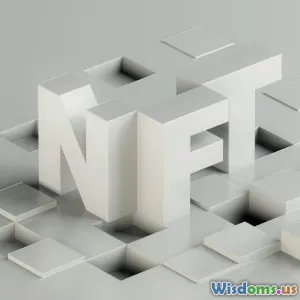
How Tokenization Shapes Modern NLP Workflows in ECommerce Applications
8 min read Explore how tokenization revolutionizes NLP in eCommerce, optimizing workflows and enhancing customer experience through advanced language processing techniques. (0 Reviews)
How Tokenization Shapes Modern NLP Workflows in eCommerce Applications
Introduction
Imagine searching for a new pair of running shoes online, but the platform struggles to understand what you mean by "Nike Air Zoom Pegasus" or fails to recognize when you ask about "20% off women's winter coats." Behind the scenes, this challenge is largely addressed by tokenization, a foundational technique in natural language processing (NLP).
Tokenization isn’t just splitting text into pieces—it’s the critical first step that determines the quality of downstream NLP tasks, especially in eCommerce, where user queries are diverse, complex, and often ambiguous. This article unpacks how tokenization shapes modern NLP workflows in eCommerce, enabling smarter search engines, personalized recommendations, and enhanced customer engagement.
Understanding Tokenization in NLP
What is Tokenization?
Tokenization is the process of converting raw text into smaller, manageable units called tokens, which can be words, subwords, or even characters. In NLP, these tokens become the basic building blocks for algorithms to analyze, understand, and generate human language.
For example, the sentence "Buy 2 iPhones" might tokenize into ["Buy", "2", "iPhones"]. However, tokenization is not always straightforward. Consider compound words, slang, emojis, or domain-specific jargon common in eCommerce:
- "iPhone12" might be tokenized as "iPhone" + "12" or as one token.
- Emojis like "😊" can convey important customer sentiment.
Why Tokenization is Critical for eCommerce
In eCommerce, tokenization impacts:
- Search Queries: Accurate tokenization preserves product names, sizes, and discounts.
- Product Descriptions: Ensures consistent understanding across millions of SKUs.
- User Reviews: Captures sentiment and intent by recognizing nuanced text elements.
An incorrect tokenization can cause failures in matching queries to products, resulting in lost sales and poor user experience.
Advances in Tokenization Techniques Relevant to eCommerce
Traditional Word-Based Tokenization
Early NLP systems primarily used whitespace and punctuation to separate tokens. While simple, this struggles with:
- Compound Words: "smartphone" vs. "smart phone"
- Misspellings or slang: "luv" vs. "love"
This can be particularly problematic in fast-evolving eCommerce language.
Subword Tokenization
Modern NLP frameworks increasingly leverage subword tokenization (e.g., Byte-Pair Encoding (BPE), WordPiece) that breaks rare words into smaller units. This approach helps handle:
- Out-of-vocabulary terms: Product model numbers (e.g., "GalaxyS21Ultra")
- Multilingual products and queries: Critical for global eCommerce platforms
Example: Tokenizing "SamsungGalaxy" might yield ["Samsung", "Galaxy"] rather than misinterpreting it as multiple unrelated tokens.
Character-Level Tokenization and Hybrid Approaches
Especially useful for typos or morphological variants:
- Customers often type "iphon" instead of "iPhone," and character-level tokenization enables models to infer the intended word.
- Hybrid methods combine word and character tokenization for robustness.
Impact of Tokenization on eCommerce NLP Workflows
Enhanced Search Engine Performance
Elastic search engines and NLP-powered search rely heavily on tokens to index and retrieve results.
An advanced tokenization strategy:
- Improves recall: Accurately maps variations of product names and slang
- Boosts precision: Avoids irrelevant matches by respecting domain-specific phrases
Case Study: Amazon uses subword tokenization in its internal NLP systems to parse user queries like "budget 4K TV" precisely, retrieving relevant affordable model options even when exact matches aren't in the product title.
Smarter Product Recommendations
Recommendation engines use tokenized customer reviews, queries, and browsing behavior to understand preferences.
Token-level embeddings capture semantic meaning and allow:
- Better matching of customer intent with product attributes
- Identification of trends from emerging jargon or new product lines
For instance, Netflix’s recommender system employs contextual embeddings from tokenized text data to suggest niche categories, an approach increasingly mirrored in eCommerce.
Sentiment and Review Analysis
Customer feedback often contains emotive language, abbreviations, and informal expressions.
Tokenization that recognises these subtleties enhances sentiment classification accuracy.
- Detects sarcasm or modifiers like "not bad" vs. "bad"
- Parses emojis and ratings embedded in text
Chatbots and Virtual Assistants
Virtual assistants powering customer service require robust tokenization to accurately parse multi-turn dialogues.
- Tokenization enables entity recognition (product names, quantities) for task automation
- Supports context retention across conversation turns
Real-World Challenges of Tokenization in eCommerce NLP
Handling Domain-Specific Vocabulary
Products across categories (fashion, electronics, grocery) use specialized terms. Tokenization must adapt dynamically.
Multilingual and Code-Switching Queries
Global markets mean many users mix languages, e.g., "Comprar zapatillas Nike barato". Tokenizers must identify language boundaries.
Noisy and Informal Customer Inputs
Typographical mistakes, emojis, abbreviations, and slang challenge tokenizers.
Scalability and Efficiency
High-volume eCommerce platforms process millions of queries daily. Tokenization must be fast and accurate.
Emerging Trends and Future of Tokenization in eCommerce NLP
Contextual Tokenization Powered by Deep Learning
Recent advances in NLP models like transformers enable dynamic tokenization adapted to context rather than static heuristics.
Integration with Knowledge Graphs
Tokenization combined with semantic networks enhances entity disambiguation and product understanding.
Personalization at Token Level
Future workflows will tailor tokenization strategies based on individual user behavior and preferences for hyper-personalized experience.
Conclusion
Tokenization, often overlooked as just a preprocessing step, is at the heart of successful NLP workflows in eCommerce applications. Its evolving techniques allow platforms to truly understand user intent, optimize search relevancy, refine product recommendations, and deliver seamless customer interactions in a highly competitive digital marketplace.
Businesses that invest in sophisticated tokenization strategies set themselves apart by transforming unstructured textual data into actionable insights and delightful user experiences. As eCommerce continues its global expansion, mastering tokenization will remain a key differentiator in NLP-driven innovation.
References
- Jurafsky, D., & Martin, J. H. (2021). Speech and Language Processing.
- Amazon Science Blog: "Advancing Search at Amazon"
- Goldberg, Y. (2017). Neural Network Methods for Natural Language Processing.
- Google Research on WordPiece Tokenization
- McKinsey & Company, The state of NLP in Retail
By embracing tokenization's nuanced role, eCommerce platforms unlock the full potential of NLP to satisfy and anticipate customer needs like never before.
Rate the Post
User Reviews
Popular Posts

















